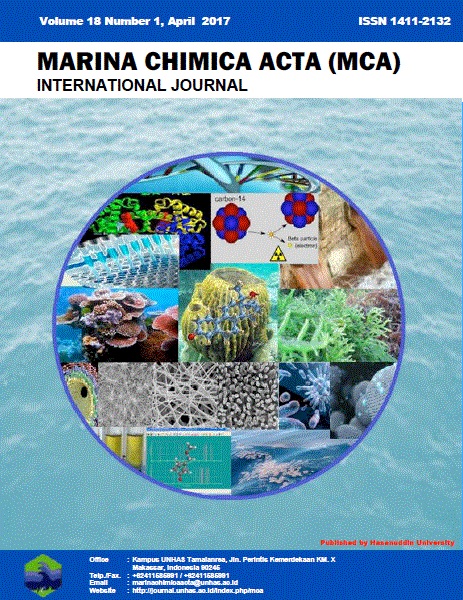ANALYSIS OF IODINE CONTENT IN SEAWEED AND ESTIMATION OF IODINE INTAKE
Abstract
ABSTRACT
Seaweed has become food the most popular in many Asian countries because apart from has a distinctive taste, seaweeds having the mineral content needed by the body. Seaweed iodine containing minerals being obtained from sea water, who was one of micro nonmetallic minerals which is very much needed by the body. Lack of iodine can cause cretinism, hyacinth, and the production of hormone low ( hypothyroidism due to enlargement the thyroid gland. Excess intake iodine also can cause an impairment of health. Recommendations intake iodine per day of by 0.15 mg/day. The purpose of this research to know the iodine on seaweed (seaweed ) in the village Punaga sub district Mangarabombang district Takalar. The kind of research laboratory this is a observation to technique quantitative analysis. Technique the sample collection in purposive sampling as many as 5 samples. Next sample each in destructor dry then examined in of the spectrophotometer Uv-visible at wavelengths 463,9 nm. Based on research results obtained levels of iodine on seaweed (seaweed ) are 1.72 µg/g, 1.92 µg/g, 1.73 µg/g, 1.94 µg/g, and 1.89 µg/g it shows that seaweed has any iodine high.References
Department of Marine and Fisheries Takalar. 2010. Profil Kelautan dan Perikanan Kabupaten Takalar. Takalar
Suparman. 2013. Cara Mudah Budidaya Rumpu Laut. Pustaka Baru Press. Yogyakarta.
MacArtain P, Gill CI, Brooks M, et al. 2007. Nutritional value of edible seaweeds. Nutrition Review. Vol 65 No 12: 535-543
Dawczynski C, Schaefer U, Leiterer M, et al. 2007. Nutritional and toxicological importance of macro, trace, and ultra-trace elements in algae food products. J Agric Food Chem. Vol. 55 No. 25:10470-10475.
Winarno, F. G.1990. Teknologi Pengolahan Rumput Laut. Pustaka Sinar Harapan. Jakarta.
Zimmermann MB. 2011. The role of iodine in human growth and development. Semin Cell Dev Biol 22:645-652.
Adriana, M., Wirjatmadi, B. 2013. Pengantar Gizi Masyarakat. Kencana Prenada Media Group. Jakarta.
Departement of Health. 2004. Analisis situasi Gizi dan Kesehatan Masyarakat. Jakarta
WHO. 1989. Toxicological evaluation of certain food additives and contaminants. WHO Food Additives Series 24. Geneva: World Health Organization
Djokomoeldjanto,F. 2005. Iodium Pangan. www.websisni_bsn.go.id.
Silaban, B dan Nanlohy, E.M. Nutrition Profile of Sipuncula (Peanut Worm): The Controvertive Marine Biota in Nusalaut Island, Center Mollucas. Jurnal Manajemen Sumber Daya Peraiaran. Vol. 7 No. 2 : 32-41
Prasetyarto dan Suhendar. 2010. Modul Tentang Laut dan Pesisir. Jakarta.
Yeh, T S., Hung N H., Lin T C. 2014. Analysis of iodine content in seaweed by GC-ECD and estimation of iodine intake. Vol 22 : 189-196.
Purawisastra, S. Komari, dan D.S. Slamet. 1987. Kadar Yodium dalam Beberapa Bahan Makanan. Media Teknologi Pangan, 3 (34) : 38-41

